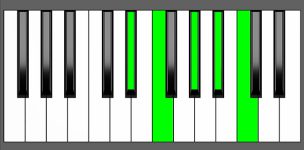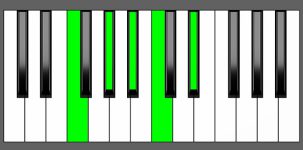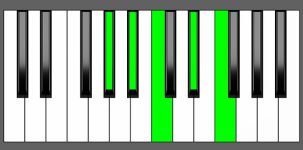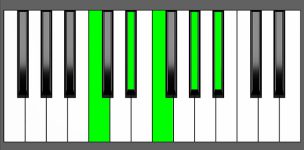Piano Diagram of A#9sus4 in Root Position
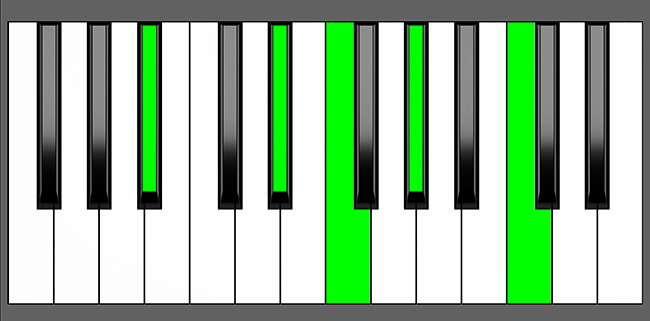
The A#9sus4 chord is a suspended dominant 9th chord built upon the key of A#. It is comprised of the root note A#, the perfect 4th D#, the perfect 5th E#, the minor 7th G#, and the major 9th B# (C). Keep reading to gain a deeper understanding of the music theory behind this chord.
Structure of A#9sus4
Notes |
|---|
| A#, D#, E#, G#, B# |
Intervals |
|---|
| R, 4, 5, m7, 9 |
How to play an A#9sus4
You can start by playing the root note A# with your left hand. Then, with your right hand, you can play the 4th D#, the minor 7th G#, and the 9th note B#. You can add the 5th, E#, to get a little bit of dissonance.
A# + (D#, G#, B#)
This will result in a simplified A#9sus4 chord that consists of the root note, perfect 4th, minor 7th, and the 9th notes only.
Another simple way to voice this chord is to play the root note with your left hand and an E# (F) min7 chord with your right hand.
A# + E#m7 =
A# + (E#, G#, B#, D#) =
A#9sus4
This voicing is essentially the second inversion of a 9sus4 chord without the root note, which is equivalent in sound to a minor 7th chord built on the 5th note from the root.
A#9sus4 Chord Inversions
The A#9sus4 chord has a total of 4 inversions:
| Root Position: | A# | D# | E# | G# | B# |
| 1st Inversion: | D# | E# | G# | A# | B# |
| 2nd Inversion: | E# | G# | A# | B# | D# |
| 3rd Inversion: | G# | A# | B# | D# | E# |
| 4th Inversion: | B# | D# | E# | G# | A# |
Piano Keyboard Diagrams

Chord Inversions on Piano
While chord inversions are a fundamental concept in music theory, the diagrams that show the sequence of notes in a complex chord on a piano keyboard may not necessarily be practical for playing. This is because proper chord voicings involve distributing the notes of the chord across different octaves and positions on the keyboard. This can be very different from the basic shape of the chord’s inversions. Therefore, the diagrams of chord inversions are mainly intended to show the sequence of notes on the piano keyboard for music theory purposes, rather than for practical playing.
Music Theory and Harmony of A#9sus4
What are Suspended Chords?
Suspended chords are a type of chord where the third note is replaced by either a major second or a perfect fourth. This creates sus2 and sus4 chords, which have a unique and sometimes unresolved sound that adds tension and color to music. These chords can be used as substitutes for major and minor chords because of their neutral nature.
The 9sus4 chord is a more intricate version of the sus4 chord, featuring a minor 7th and 9th note in addition to the perfect fourth. This chord is commonly used in jazz and blues music to add complexity and interest to chord progressions. It is often used as a substitute for dominant 7th chords. Read on to learn how to build an A#9sus4 chord, or scroll down to see where it can be used in different keys and degrees.
Building the A#9sus4 Chord: Different Approaches
Starting from a Major Scale
To create a 9sus4 chord, you can use the Major scale as a reference by combining a Root, a 4th, a 5th, a minor 7th, and a 9th.
In this case, to build an A#9sus4 let’s start from the A# Major scale, which includes the notes A#, B#, Cx, D#, E#, Fx, and Gx.


Apply the formula R, 4°, 5°, m7°, 9° to get an A#9sus4 chord.
- Select the Root note, which is A#.
- Pick the 4th note, which is D#.
- Add the 5th note, which is E#.
- To add the 7th note, we need to use a minor 7th interval, which means we must use a flat seventh. In the A# Major scale, the 7th note is Gx, so the minor 7th is G#.
- Lastly, include the 9th note of the A# Major scale, which is B#.
by Combining Intervals
To build a 9sus4 chord, you can stack together a perfect 4th, a whole-tone (or major 2nd), a minor 3rd, and a major 3rd.
4 + 2 + m3 + 3 = 9sus4 Chords
When building an A#9sus4 chord, you can see that A#-D# is a perfect 4th, D#-E# is a major 2nd, E#-G# is a minor 3rd, and G#-B# is a major 3rd.
How to Use A#9sus4 in a Chord Progression
Suspended chords have a unique quality that sets them apart from major and minor chords. They are neither major nor minor, which makes them a useful tool for creating tension and suspense in a musical composition before resolving to a stable major or minor chord.
To use an A#9sus4 chord in a chord progression, you can refer to the following tables, which show the most common positions where the chord can be found or used. However, it’s important to note that, since this chord features a minor 7th, it cannot be used with Maj7 chords, such as sus2 or sus4 chords. Nonetheless, it can be used on dominant chords and in all positions where an A#m7 is present.
A#9sus4 as Substitute of A#7
A#9sus4 can be used as a substitute for A#7 chord in major and minor keys. In D# major, A#7 can be replaced with A#9sus4 in the V position. Similarly, in the B# minor key, A#7 can be substituted with A#9sus4 in the VII position. However, considering that D# major and B# minor are theoretical keys, it is far more practical to use its enharmonic equivalent Bb9sus4, in the keys of Eb major and C minor.
on Major Scales
| Major Scales | I | ii | iii | IV | V | vi | vii |
|---|---|---|---|---|---|---|---|
| D# = Eb | Eb Maj7 | F min7 | G min7 | Ab Maj7 | Bb7 ⇒ Bb9sus4 = A#9sus4 | C min7 | Dm7b5 |
- Dominant chord in Eb Major as Bb9sus4
on Natural minor Scales
| Minor Scales | i | ii | III | iv | v | VI | VII |
|---|---|---|---|---|---|---|---|
| B# = C | C min7 | Dm7b5 | Eb Maj7 | F min7 | G min7 | Ab Maj7 | Bb7 ⇒ Bb9sus4 = A#9sus4 |
- Leading tone chord in C minor as Bb9sus4
A#9sus4 as Substitute of A#m7
The A#9sus4 chord serves as a viable alternative to the A# minor 7th chord in multiple major and minor keys. However, it’s worth noting that in the keys of F# Major and D# minor, the presence of the note B# may clash with the B notes inherent to those keys. While this doesn’t necessarily prohibit the use of the A#9sus4 chord in those contexts, it’s crucial to acknowledge that it can introduce a significant dissonance when combined with the melody or other components of the composition.
on Major Scales
| Major Scales | I | ii | iii | IV | V | vi | vii |
|---|---|---|---|---|---|---|---|
| G# = Ab | Ab Maj7 | Bb7 ⇒ Bb9sus4 = A#9sus4 | C min7 | Db Maj7 | Eb7 | F min7 | Gm7b5 |
| F# | F# Maj7 | G# min7 | A#m7 ⇒ A#9sus4 | B Maj7 | C#7 | D# min7 | E#m7b5 |
| C# | C# Maj7 | D# min7 | E# min7 | F# Maj7 | G#7 | A#m7 ⇒ A#9sus4 | B#m7b5 |
- Supertonic chord in Ab Major as Bb9sus4
- Non Diatonic Mediant chord in F# Major
- Submediant chord in C# Major
on Natural minor Scales
| Minor Scales | i | ii | III | iv | v | VI | VII |
|---|---|---|---|---|---|---|---|
| A# | A#m7 ⇒ A#9sus4 | B#m7b5 | C# Maj7 | D# min7 | E# min7 | F# Maj7 | G#7 |
| E# = F | F min7 | Gm7b5 | Ab Maj7 | Bb7 ⇒ Bb9sus4 = A#9sus4 | C min7 | Db Maj7 | Eb7 |
| D# | D# min7 | E#m7b5 | F# Maj7 | G# min7 | A#m7 ⇒ A#9sus4 | B Maj7 | C#7 |
- Tonic chord in A# minor
- Subdominant chord in F minor as Bb9sus4
- Non Diatonic Dominant chord in D# minor
A#9sus4 in D# Major
Check Bb9sus4 in Eb Major
A#9sus4 in B# Minor
Check Bb9sus4 in C minor
A#9sus4 in G# Major
Check Bb9sus4 in Ab Major
A#9sus4 in F# Major (Non Diatonic)
When playing in the F# Major key, you can use the A#9sus4 chord as a non-diatonic substitution for the A# minor chord on the III degree. However, it’s essential to note that the A#9sus4 chord includes a B# (C), which may clash with the natural B note present in the F# Major scale.
| I | ii | iii | IV | V | vi | vii |
| F# Maj7 | G# min7 | A# min7 | B Maj7 | C#7 | D# min7 | E#m7b5 |
A#9sus4 Chord Progressions as iii degree
I iii IV V
| I | iii | IV | V |
| F# Maj7 | A#9sus4 | A#m7 | B Maj7 | C#7 |
I iii ii V
| I | iii | ii | V |
| F# Maj7 | A#9sus4 | A#m7 | G# min7 | C#7 |
I iii vi IV
| I | iii | vi | IV |
| F# Maj7 | A#9sus4 | A#m7 | D# min7 | B Maj7 |
A#9sus4 in C# Major
In the key of C# Major, you can use the A#9sus4 chord as a replacement for the VI degree chord, where an A# minor chord would typically be played.
| I | ii | iii | IV | V | vi | vii |
| C# Maj7 | D# min7 | E# min7 | F# Maj7 | G#7 | A# min7 | B#m7b5 |
A#9sus4 as vi degree – Chord Progressions
I iii vi V
| I | iii | vi | V |
| C# Maj7 | E# min7 | A#9sus4 | A#m7 | G#7 |
I vi ii V
| I | vi | ii | V |
| C# Maj7 | A#9sus4 | A#m7 | D# min7 | G#7 |
I IV ii V iii vi ii V
| I | IV | ii | V | iii | vi | ii | V |
| C# Maj7 | F# Maj7 | D# min7 | G#7 | E# min7 | A#9sus4 | A#m7 | D# min7 | G#7 |
A#9sus4 in A# Minor
In the key of A# minor, incorporating the A#9sus4 chord can add variation to the traditional A#m chord typically used in the key.
| i | ii | III | iv | v | VI | VII |
| A# min7 | B#m7b5 | C# Maj7 | D# min7 | E# min7 | F# Maj7 | G#7 |
A#9sus4 Chord Progressions as i degree
i VI VII
| i | VI | VII |
| A#9sus4 | A#m7 | F# Maj7 | G#7 |
i iv VI VII
| i | iv | VI | VII |
| A#9sus4 | D# min7 | F# Maj7 | G#7 |
A#9sus4 in E# Minor
Check Bb9sus4 in F minor
A#9sus4 in D# Minor (Non Diatonic)
In the key of D# minor, you can use the A#9sus4 chord as an alternative or substitution for the v degree chord. However, it’s important to note that the A#9sus4 chord contains a B# (natural C), which is not diatonic to the D# minor scale that includes a natural B. As a result, it’s generally recommended to avoid using the A#9sus4 chord in this context, but it’s worth experimenting to see if it suits your desired sound.
| i | ii | III | iv | v | VI | VII |
| D# min7 | E#m7b5 | F# Maj7 | G# min7 | A# min7 | B Maj7 | C#7 |
A#9sus4 as v degree – Chord Progressions
i iv VI v
| i | iv | VI | v |
| D# min7 | G# min7 | B Maj7 | A#9sus4 | A#m7 |
i v VI VII
| i | v | VI | VII |
| D# min7 | A#9sus4 | A#m7 | B Maj7 | C#7 |
i VI v iv
| i | VI | v | iv |
| D# min7 | B Maj7 | A#9sus4 | A#m7 | G# min7 |
9sus4 and 11th Chords: Similarities and Differences
9sus4 chords share almost the same notes as 11th chords. The only difference is the presence of the 3rd in 11th chords.
A#9sus4 = A#, D#, E#, G#, B#
A#11 = A#, Cx, E#, G#, B#, D#
However, it is important to note that a 4th is not the same as an 11th, even if they are the same note. There is an octave of difference between them. This distinction may not matter when playing an inversion of the chord, but it is still important to be aware of.
Alternative A#9sus4 Chord Nomenclature
- A#9 sus4
- A#7(9sus4)
- A#9sus 4th
- A# nine suspended 4th
- A# ninth suspended fourth
- A# Dominant ninth suspended 4
